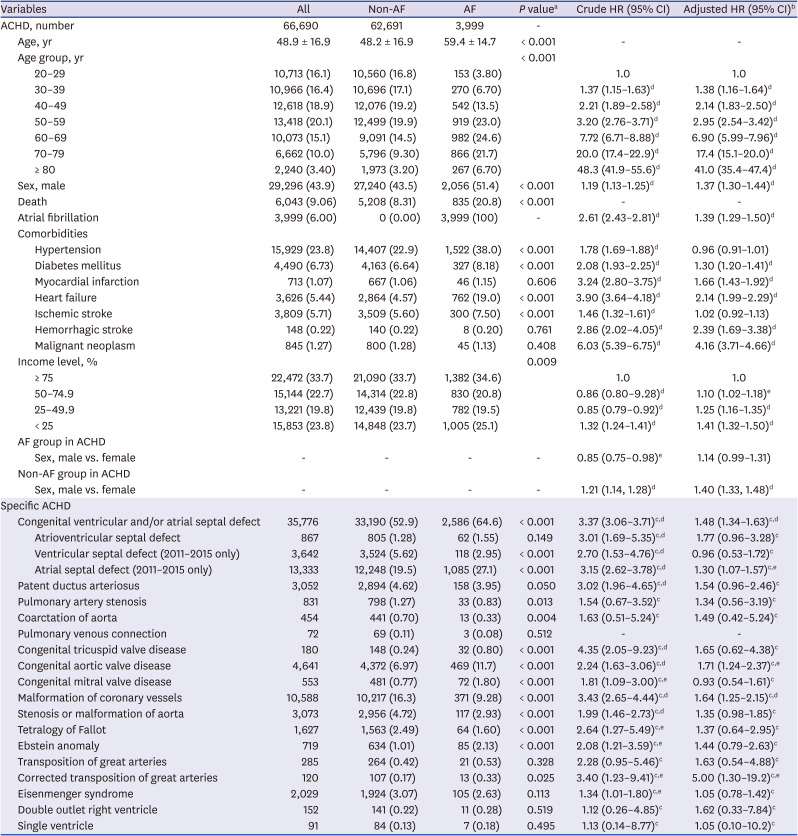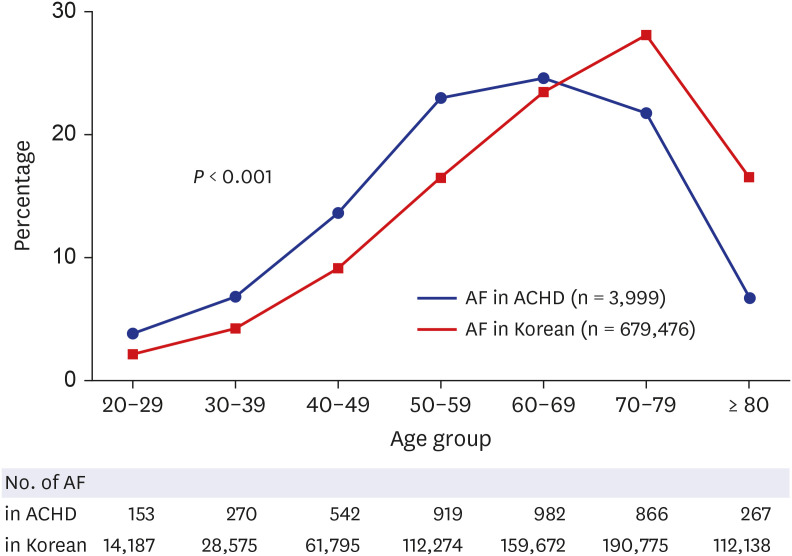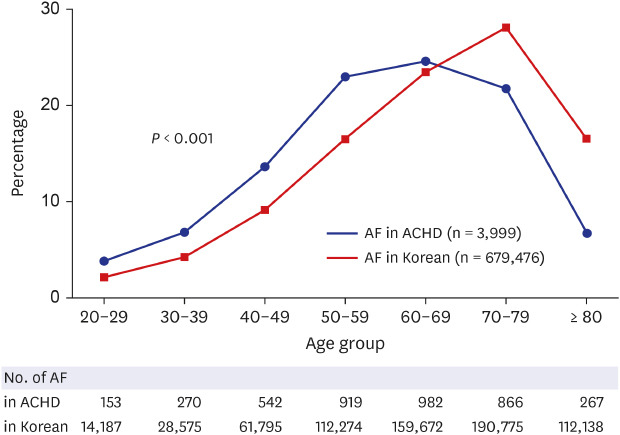1. Ávila P, Mercier LA, Dore A, Marcotte F, Mongeon FP, Ibrahim R, et al. Adult congenital heart disease: a growing epidemic. Can J Cardiol. 2014; 30(12 Suppl):S410–9. PMID:
25432136.

2. Wasmer K, Eckardt L. Management of supraventricular arrhythmias in adults with congenital heart disease. Heart. 2016; 102(20):1614–1619. PMID:
27312002.


3. Miyasaka Y, Barnes ME, Gersh BJ, Cha SS, Bailey KR, Abhayaratna WP, et al. Secular trends in incidence of atrial fibrillation in Olmsted County, Minnesota, 1980 to 2000, and implications on the projections for future prevalence. Circulation. 2006; 114(2):119–125. PMID:
16818816.


4. Krijthe BP, Kunst A, Benjamin EJ, Lip GY, Franco OH, Hofman A, et al. Projections on the number of individuals with atrial fibrillation in the European Union, from 2000 to 2060. Eur Heart J. 2013; 34(35):2746–2751. PMID:
23900699.



5. Stefansdottir H, Aspelund T, Gudnason V, Arnar DO. Trends in the incidence and prevalence of atrial fibrillation in Iceland and future projections. Europace. 2011; 13(8):1110–1117. PMID:
21551478.


6. Craig RJ, Selzer A. Natural history and prognosis of atrial septal defect. Circulation. 1968; 37(5):805–815. PMID:
5646864.


7. Waldmann V, Laredo M, Abadir S, Mondésert B, Khairy P. Atrial fibrillation in adults with congenital heart disease. Int J Cardiol. 2019; 287:148–154. PMID:
30712848.

8. John Sutton MG, Tajik AJ, McGoon DC. Atrial septal defect in patients ages 60 years or older: operative results and long-term postoperative follow-up. Circulation. 1981; 64(2):402–409. PMID:
6788403.


9. Ebrahim MA, Escudero CA, Kantoch MJ, Vondermuhll IF, Atallah J. Insights on atrial fibrillation in congenital heart disease. Can J Cardiol. 2018; 34(11):1531–1533. PMID:
30404756.


10. Kim D, Yang PS, Jang E, Yu HT, Kim TH, Uhm JS, et al. 10-year nationwide trends of the incidence, prevalence, and adverse outcomes of non-valvular atrial fibrillation nationwide health insurance data covering the entire Korean population. Am Heart J. 2018; 202:20–26. PMID:
29802976.


11. Lee J, Lee JS, Park SH, Shin SA, Kim K. Cohort profile: The National Health Insurance Service-National Sample Cohort (NHIS-NSC), South Korea. Int J Epidemiol. 2017; 46(2):e15. PMID:
26822938.

14. Jang SY, Park TK, Kim DK. Survival and causes of death for Takayasu's arteritis in Korea: a retrospective population-based study. Int J Rheum Dis. 2021; 24(1):69–73. PMID:
33089946.


15. Jang SY, Seo SR, Moon JR, Cho EJ, Kim E, Chang SA, et al. Prevalence and mortality of congenital heart disease in Korean adults. Medicine (Baltimore). 2018; 97(27):e11348. PMID:
29979412.

16. Rothman KJ, Greenland S, Lash TL. Modern Epidemiology. 3rd ed. Philadelphia: Lippincott Williams & Wilkins;2008.
17. Jang SY, Seo SR, Park SW, Kim DK. The prevalence of Marfan syndrome in Korea. J Korean Med Sci. 2017; 32(4):576–580. PMID:
28244281.



18. Bouchardy J, Therrien J, Pilote L, Ionescu-Ittu R, Martucci G, Bottega N, et al. Atrial arrhythmias in adults with congenital heart disease. Circulation. 2009; 120(17):1679–1686. PMID:
19822808.


19. Yang H, Kuijpers JM, de Groot JR, Konings TC, van Dijk A, Sieswerda GT, et al. Impact of atrial arrhythmias on outcome in adults with congenital heart disease. Int J Cardiol. 2017; 248:152–154. PMID:
28942870.


20. Labombarda F, Hamilton R, Shohoudi A, Aboulhosn J, Broberg CS, Chaix MA, et al. Increasing prevalence of atrial fibrillation and permanent atrial arrhythmias in congenital heart disease. J Am Coll Cardiol. 2017; 70(7):857–865. PMID:
28797355.


21. Moe TG, Abrich VA, Rhee EK. Atrial fibrillation in patients with congenital heart disease. J Atr Fibrillation. 2017; 10(1):1612. PMID:
29250225.



22. Hu WS, Lin CL. Risk of atrial fibrillation in patients with congenital heart disease: results of a propensity score-matched, nationwide cohort study. J Atheroscler Thromb. 2019; 26(7):670–677. PMID:
31231081.



23. Ueda A, Adachi I, McCarthy KP, Li W, Ho SY, Uemura H. Substrates of atrial arrhythmias: histological insights from patients with congenital heart disease. Int J Cardiol. 2013; 168(3):2481–2486. PMID:
23541611.


24. Andrade J, Khairy P, Dobrev D, Nattel S. The clinical profile and pathophysiology of atrial fibrillation: relationships among clinical features, epidemiology, and mechanisms. Circ Res. 2014; 114(9):1453–1468. PMID:
24763464.

25. Choi B, Jang SY, Kim SK, Kim N, Kim K, Kim DK. The incidence, prevalence, and survival rate of thromboangiitis obliterans in Korea: a retrospective population-based study. Cardiovasc Diagn Ther. 2020; 10(5):1238–1244. PMID:
33224747.



26. Shin HY, Lee JY, Song J, Lee S, Lee J, Lim B, et al. Cause-of-death statistics in the Republic of Korea, 2014. J Korean Med Assoc. 2016; 59(3):221–232.

27. Jo MW, Seo W, Lim SY, Ock M. The trends in health life expectancy in Korea according to age, gender, education level, and subregion: using quality-adjusted life expectancy method. J Korean Med Sci. 2019; 34(Suppl 1):e88. PMID:
30923491.

28. Mandalenakis Z, Rosengren A, Lappas G, Eriksson P, Gilljam T, Hansson PO, et al. Atrial fibrillation burden in young patients with congenital heart disease. Circulation. 2018; 137(9):928–937. PMID:
29092907.


29. Bokma JP, Zegstroo I, Kuijpers JM, Konings TC, van Kimmenade RR, van Melle JP, et al. Factors associated with coronary artery disease and stroke in adults with congenital heart disease. Heart. 2018; 104(7):574–580. PMID:
28847851.


30. Yalonetsky S, Horlick EM, Osten MD, Benson LN, Oechslin EN, Silversides CK. Clinical characteristics of coronary artery disease in adults with congenital heart defects. Int J Cardiol. 2013; 164(2):217–220. PMID:
21807422.


31. Giang KW, Mandalenakis Z, Dellborg M, Lappas G, Eriksson P, Hansson PO, et al. Long-term risk of hemorrhagic stroke in young patients with congenital heart disease. Stroke. 2018; 49(5):1155–1162. PMID:
29626133.



32. Sung J, Song YM, Hong KP. Relationship between the shift of socioeconomic status and cardiovascular mortality. Eur J Prev Cardiol. 2020; 27(7):749–757. PMID:
31180761.


33. Huh J. Arrhythmias in postoperative congenital heart diseases. Int J Arrhythm. 2010; 11(4):34–42.
34. Park SW. Arrhythmia after cardiac surgery. Int J Arrhythm. 2010; 11(4):22–25.
35. Karbassi A, Nair K, Harris L, Wald RM, Roche SL. Atrial tachyarrhythmia in adult congenital heart disease. World J Cardiol. 2017; 9(6):496–507. PMID:
28706585.



36. Jang SY, Ju EY, Seo SR, Choi JY, Park SJ, Kim DK, et al. Changes in the etiology of valvular heart disease in the rapidly aging Korean population. Int J Cardiol. 2014; 174(2):355–359. PMID:
24794955.









 PDF
PDF Citation
Citation Print
Print





 XML Download
XML Download